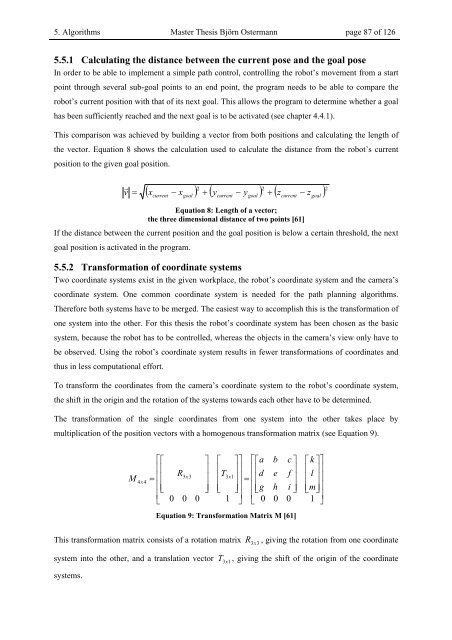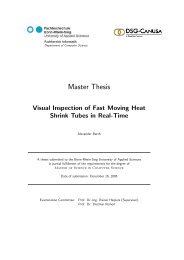Master Thesis - Hochschule Bonn-Rhein-Sieg
Master Thesis - Hochschule Bonn-Rhein-Sieg
Master Thesis - Hochschule Bonn-Rhein-Sieg
You also want an ePaper? Increase the reach of your titles
YUMPU automatically turns print PDFs into web optimized ePapers that Google loves.
5. Algorithms <strong>Master</strong> <strong>Thesis</strong> Björn Ostermann page 87 of 126<br />
5.5.1 Calculating the distance between the current pose and the goal pose<br />
In order to be able to implement a simple path control, controlling the robot’s movement from a start<br />
point through several sub-goal points to an end point, the program needs to be able to compare the<br />
robot’s current position with that of its next goal. This allows the program to determine whether a goal<br />
has been sufficiently reached and the next goal is to be activated (see chapter 4.4.1).<br />
This comparison was achieved by building a vector from both positions and calculating the length of<br />
the vector. Equation 8 shows the calculation used to calculate the distance from the robot’s current<br />
position to the given goal position.<br />
� � � � � �2 2<br />
2<br />
x � x � y � y � z z<br />
�<br />
v �<br />
�<br />
current<br />
goal<br />
current<br />
Equation 8: Length of a vector;<br />
the three dimensional distance of two points [61]<br />
If the distance between the current position and the goal position is below a certain threshold, the next<br />
goal position is activated in the program.<br />
5.5.2 Transformation of coordinate systems<br />
Two coordinate systems exist in the given workplace, the robot’s coordinate system and the camera’s<br />
coordinate system. One common coordinate system is needed for the path planning algorithms.<br />
Therefore both systems have to be merged. The easiest way to accomplish this is the transformation of<br />
one system into the other. For this thesis the robot’s coordinate system has been chosen as the basic<br />
system, because the robot has to be controlled, whereas the objects in the camera’s view only have to<br />
be observed. Using the robot’s coordinate system results in fewer transformations of coordinates and<br />
thus in less computational effort.<br />
To transform the coordinates from the camera’s coordinate system to the robot’s coordinate system,<br />
the shift in the origin and the rotation of the systems towards each other have to be determined.<br />
The transformation of the single coordinates from one system into the other takes place by<br />
multiplication of the position vectors with a homogenous transformation matrix (see Equation 9).<br />
M<br />
4 x 4<br />
��<br />
��<br />
� ��<br />
���<br />
�<br />
�<br />
0<br />
R<br />
3x<br />
3<br />
0<br />
0<br />
�<br />
�<br />
�<br />
��<br />
goal<br />
� ��<br />
��a<br />
� � �<br />
T<br />
� �<br />
� 3x1<br />
��<br />
� �<br />
d<br />
�<br />
��<br />
��<br />
� ���<br />
g<br />
1 � �<br />
� � 0<br />
b<br />
e<br />
h<br />
0<br />
current<br />
c �<br />
f<br />
�<br />
�<br />
i ��<br />
0<br />
Equation 9: Transformation Matrix M [61]<br />
goal<br />
� k ��<br />
� �<br />
l<br />
�<br />
� ��<br />
��<br />
m��<br />
�<br />
1 �<br />
�<br />
This transformation matrix consists of a rotation matrix R 3x 3 , giving the rotation from one coordinate<br />
system into the other, and a translation vector T 3x1<br />
, giving the shift of the origin of the coordinate<br />
systems.














